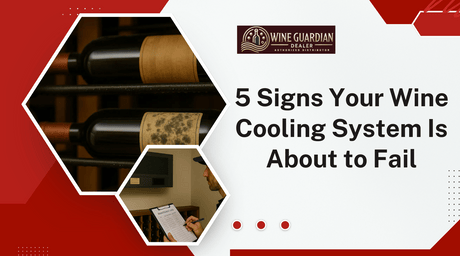
5 Signs Your Wine Cooling System Is About to Fail
Don’t wait for a costly surprise. Wine Guardian Dealer breaks down the top 5 signs your wine cooling system may be failing — and how to fix it before damage...
Jim Hopper
In Stock & Ready to Ship – Order Your Wine Cooling System Today!
Free Wine Cellar Expert Consultation | 📞 Call 1-800-260-1712
Start with a free expert consult—cooling system sizing, racking options, and no upsells.
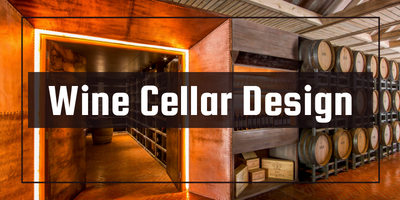
Build your dream wine cellar—without costly mistakes or guesswork.
Choosing the right wine cellar cooling system is crucial for maintaining optimal wine storage conditions. Two primary options dominate the market: self-contained wine cooling units and split wine cellar cooling systems. This guide — informed by our complete Wine Cooling Reviews and Buying Guides — explores their key differences, advantages, and which option best suits your needs.
By Jim Hopper, Wine Cooling Expert

Wine cellar cooling systems are designed to provide optimal storage conditions for wine collections. These systems are essential for maintaining the quality and longevity of wine, as they control temperature, humidity, and noise levels within the cellar. By maintaining these critical factors, wine cellar cooling systems ensure that your wine ages gracefully and retains its intended flavor and aroma.
A wine cellar cooling system is a device or set of devices that regulate the temperature and humidity levels within a wine cellar. These systems are crucial for wine storage, as they prevent spoilage and ensure the optimal aging process. The importance of wine cellar cooling systems lies in their ability to maintain a consistent temperature between 45°F and 65°F (7°C and 18°C) and relative humidity between 50% and 70%. By maintaining these conditions, wine cellar cooling systems help preserve the integrity of your wine collection.
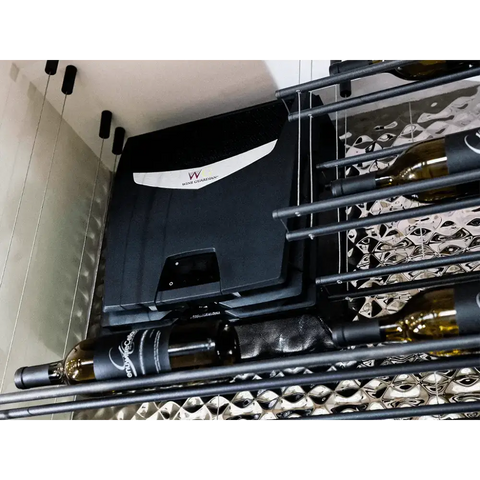
Featured Product: Wine Guardian TTW009 Through The Wall Wine Cellar Cooling Unit
A self-contained wine cooling unit is an all-in-one single unit system where both the evaporator and condenser are housed together. These units are designed for easy installation and require minimal maintenance, making them a popular choice among wine enthusiasts. Additionally, models like the WhisperKOOL Extreme Self-Contained are capable of handling very high or low outside temperatures, ensuring reliable performance in diverse environments.
The unit is installed through an exterior wall or in an adjacent room.
It vents hot air outside or into another room through an exhaust to prevent heat buildup.
Requires minimal installation effort, often a plug-and-play setup.
Temperature control is built-in, ensuring a consistent temperature inside the wine cellar.
Small to medium-sized wine cellars (up to 1,000 cubic feet).
Homeowners looking for a DIY-friendly wine cooling system.
Wine cellars with limited space for external components, where the unit must fit compactly within the available area.
Wine collectors who need an energy-efficient cooling solution.
Ideal for replacing similar-sized Wine Mate and Breezaire units, as seen with Cellar Cool Self-Contained systems.
Pros:
Generally, self-contained wine cooling units are known for their simple installation and minimal maintenance.
Simple installation.
No need for a professional HVAC system setup.
Cost-effective upfront investment.
Ideal for maintaining temperature control without complex modifications.
Designed to mount and exhaust into a living area, suggesting ease of installation and integration into home environments.
Cons:
Requires proper ventilation to prevent overheating.
Can be noisier compared to split systems due to the integrated components.
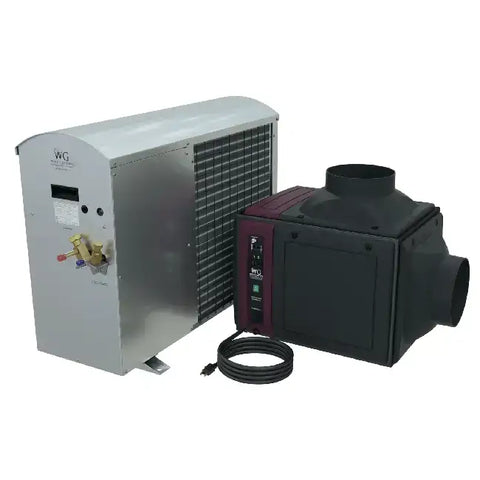
Featured Product: Wine Guardian DS025 Duct Split Wine Cellar Cooling Unit
A split wine cellar cooling system separates the condenser and evaporator, utilizing specialized equipment to offer more temperature control, quieter operation, and enhanced energy efficiency.
The evaporator is placed inside the wine room, while the condenser is installed outside or in a mechanical room.
Connected via refrigerant lines, requiring professional installation.
Designed to provide cool air while reducing noise inside the wine cellar.
Helps regulate humidity control, preventing excess moisture buildup.
Ducting is crucial for effective installation, as it facilitates the movement of air to and from the cellar. Ducted-split and air handler systems utilize ducting to distribute cooled air without exposing any equipment inside the wine cellar.
Large wine cellars (over 1,000 cubic feet).
Commercial wine storage spaces.
Homeowners prioritizing quiet operation and enhanced cooling efficiency.
Modern wine cellars requiring advanced temperature control solutions despite the higher, more expensive installation and maintenance costs.
Pros:
Quieter operation inside the wine cellar.
More powerful wine cooling system for larger spaces.
Greater flexibility in placement.
More energy-efficient compared to self-contained systems.
Effective cooling and noise reduction through the use of ducts.
Cons:
Higher installation costs.
Requires refrigerant maintenance.
More complex setup, requiring professional HVAC assistance.
|
Feature |
Self-Contained Cooling Unit |
Split Wine Cellar Cooling System |
|---|---|---|
|
Installation |
DIY, plug-and-play |
Requires professional installation |
|
Cooling Capacity |
Suitable for small to medium wine cellars |
Ideal for large wine cellars |
|
Noise Level |
Higher inside the wine cellar |
Quieter operation, condenser placed outside |
|
Maintenance |
Minimal servicing required |
Requires refrigerant maintenance |
|
Cost |
Lower upfront cost |
Higher installation and setup costs |
|
Humidity Control |
Limited control |
Advanced humidity control |
|
Factors Needed |
Basic setup needed |
Additional factors needed for ideal conditions |
Installation Complexity: DIY vs. professional HVAC system setup.
Cooling Efficiency & Power: Which system cools better?
Maintenance Requirements: Long-term upkeep considerations.
Noise Levels: Which unit operates more quietly?
Cost Considerations: Upfront investment vs. long-term savings.
Flexibility & Customization: Which wine cooling unit adapts better to different spaces?
Temperature Stability & Reactions: Maintaining a stable temperature is crucial for wine aging as it fosters desirable chemical reactions while preventing undesirable ones. Optimal conditions maximize beneficial reactions that contribute to the wine's flavors and aromas.
Additional Features: Many cooling units can be configured to add heat and/or humidity, making them adaptable to various environmental conditions.
Temperature control is a critical aspect of wine cellar cooling systems. A stable temperature ensures that the wine ages slowly and evenly, preventing spoilage and preserving its flavor and aroma. Wine cellar cooling systems use various technologies, such as vapor compression, thermoelectric cooling, or split systems, to maintain a consistent temperature. These systems are designed to hold the temperature steady, avoiding fluctuations that could negatively impact the wine.
Humidity control is another essential function of wine cellar cooling systems. A relative humidity of 50% to 70% is ideal for aging wine, as it prevents corks from drying out and ensures the optimal gas exchange. Wine cellar cooling systems use various methods, such as humidistats and misting systems, to maintain the desired humidity level. By preserving the right amount of moisture, these systems help prevent cork shrinkage and oxidation, which can spoil the wine.
Noise level and lifespan are also important considerations for wine cellar cooling systems. A quiet system ensures that the wine cellar remains a peaceful and serene environment, while a long lifespan reduces maintenance and replacement costs. Wine cellar cooling systems can last for many years, with some systems lasting up to 20 years or more with proper maintenance. By choosing a system that operates quietly and is built to last, you can enjoy a well-maintained wine cellar for years to come.
In summary, wine cellar cooling systems are essential for maintaining optimal storage conditions for wine collections. These systems control temperature, humidity, and noise levels, ensuring the quality and longevity of the wine. By understanding the importance of wine cellar cooling systems, wine enthusiasts can make informed decisions when selecting a system for their wine cellar.
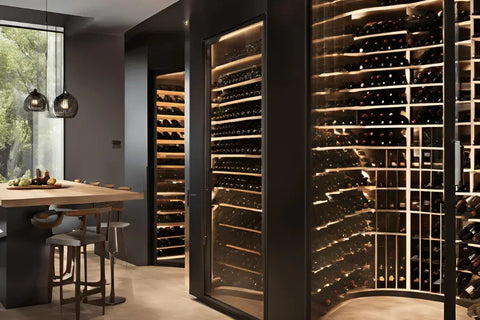
For Small to Medium Wine Cellars: A self-contained wine cooling unit is the best choice.
For Large Wine Cellars & Commercial Use: A split wine cellar cooling system provides superior cooling.
Best Cooling System for a Small Wine Cellar: Choose a self-contained unit with proper ventilation.
Energy Efficiency Considerations: Split systems often consume less energy.
Importance of Walls: Properly designed and constructed walls are crucial for insulation, structural integrity, and accommodating cooling unit installation and drainage requirements.
Wine Guardian offers some of the most advanced wine cellar cooling units designed for precision temperature control and humidity regulation. Here are the standout features that make Wine Guardian cooling systems the industry leader:
Advanced Temperature Control: Ensures a consistent temperature for wine aging.
Quiet & Efficient Operation: Designed to minimize noise while providing optimal cooling efficiency.
Flexible Installation Options: Available in self-contained, split, and ducted cooling system configurations.
Superior Humidity Control: Helps maintain the ideal wine cellar environment.
Energy-Efficient Technology: Reduces energy consumption while keeping your wine room cooling system running smoothly.
User-Friendly Digital Control Panels: Make it easy to change settings and monitor performance.
For any questions or further assistance, feel free to contact Wine Guardian.
Fully ducted for quiet, concealed operation.
Ideal for modern wine cellars with a seamless design.
Provides precise humidity control to prevent bottle cork deterioration.
Perfect for small to medium wine cellars.
Easy plug-and-play installation without extensive modifications.
Engineered for consistent temperature regulation and reliability.
Suitable for large wine cellars and commercial applications.
Separates the condenser and evaporator for whisper-quiet performance.
Customizable configurations for various cellar layouts.
Wine Guardian’s range of products ensures that no matter the size or configuration of your wine storage space, there is a cooling system that perfectly fits your needs.
Some of the best wine cooling systems include:
Wine Guardian – Industry-leading wine cellar cooling units with customizable options.
Breezaire – Offers self-contained cooling systems that are cost-effective and durable.
WhisperKOOL – Specializes in split wine cellar cooling systems and ducted cooling system options.
When purchasing a wine cellar cooling system, choosing a reputable dealer is essential. At Wine Guardian Dealer, we are the #1 choice for Wine Guardian cooling units and accessories.
Authorized Dealer: We sell only genuine Wine Guardian cooling systems with full warranties.
Expert Guidance: Our team specializes in wine cellar cooling units and can recommend the best option for your space.
Competitive Pricing: We provide the best deals on self-contained vs. ductless split cooling systems.
Hassle-Free Experience: From selection to installation, we guide you every step of the way.
Whether you're upgrading your wine room cooling system or installing a new wine cellar cooling unit, Wine Guardian Dealer has the perfect solution for you. Browse our top-rated systems now and find the best cooling unit for your wine collection!
Selecting the right wine cellar cooling unit depends on your storage space, budget, and installation preferences. A self-contained wine cooling unit is ideal for small to medium wine cellars, while a split wine cellar cooling system provides superior cooling for larger storage areas.
Need expert advice? Compare our top-rated self-contained and split cooling systems now or consult a specialist today.
A compact, all-in-one system that’s easy to install — ideal for small to medium cellars.
A two-part system (evaporator inside, condenser outside) that offers quieter, more powerful cooling for large cellars.
Self-contained is budget-friendly and DIY-ready; split systems are quieter, more efficient, and best for large or custom wine cellars.
Match it to your cellar size, layout, noise preference, and budget. For small spaces: self-contained. For large or high-end setups: split or ducted.
🛒Shop our most-loved Wine Guardian cooling systems today.
🛠️Protect your wine with the most trusted systems on the market.
❤️Tested, reviewed, and loved by serious collectors like you.